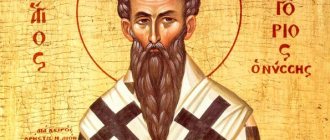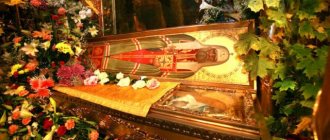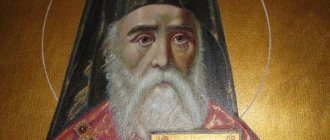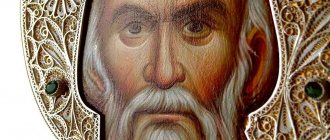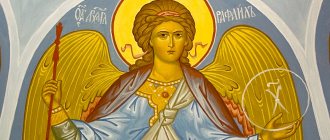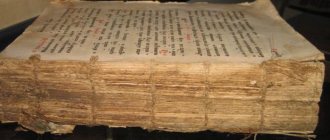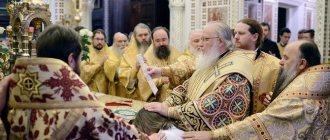Biography of Mitrofan of Voronezh
In the Orthodox world, Mitrofan (in some sources - Mitrofania) of Voronezh is considered a defender of the faith and a mentor on the true path. During his life, he helped the poor and disadvantaged, the beggars and the sick.
Mitrofan of Voronezh is a defender of the faith and a mentor on the true path
Worldly life
The life of the saint has many controversial issues. For example, the date of birth of the righteous man has not been reliably established. The most common versions are November 6 or 8, 1623.
In the late autumn of 1623, a baby appeared in a family of Christians who believed in the Almighty, who was given the name Michael. A married couple lived in the village of Antilokhovo, Vladimir province. Information about Mikhail's parents is inaccurate. Presumably the boy's father and mother were God-fearing people. Therefore, from early childhood they tried to instill in their son love for the Almighty and guide him on the true and righteous path.
More complete information about Mikhail’s childhood and adolescence is not available. It is known that in his worldly life he had a wife and children. The chronicles mention the son Ivan, for whom the future archbishop had tender parental feelings. Michael was a minister of the church and revered Jesus Christ.
The beginning of the monastic path
When the wife of the righteous man died, the clergyman took monastic vows under the name Mitrofan. This event took place in 1623 at the Zolotnikovskaya Assumption Monastery.
God's servant led a hermit's life and spent most of his time delivering prayer speeches. After three years of ascetic life, Mitrofan accepted the rank of priest. A little later he became abbot of the Kosmo-Yakhromsky monastery.
In 1675, he was elevated to the rank of archimandrite and assigned to the management of the Unzhensky tithe, which included more than 90 monasteries and churches. Tsar Fyodor Alekseevich came to the Unzhensky monastery, who enjoyed the sincere conversations with the rector of the tithe. In 1681, the Voronezh diocese was formed, the ruler of which appointed Abbot Mitrofan as bishop.
In 1681, the saint headed the Voronezh diocese
Bishop of Voronezh
Mitrofan, who was called Voronezh, took over the diocese in a very deplorable state. The region was plundered, immorality and lack of spirituality flourished everywhere. The absence of churches and monasteries (at that time there was only one Church of the Annunciation in operation) had a corresponding impact on the spiritual development of the local population.
Unpretentious and simple by nature, the Voronezh saint began to instill in Christians faith in the Lord God. At the same time, he wore simple robes made of coarse dyed linen and ate from ordinary pewter utensils. He sent almost all his income to the needs of his flock and the disadvantaged.
During the 20 years of his bishopric, Mitrofan of Voronezh increased the number of churches in the diocese to 239, raised the morality of the clergy and instilled in society faith in the Almighty. The archpastor was strict at times, but always fair.
Illness and death
According to legend, on August 2, 1703, the archpastor felt severely unwell. The sacrament of Unction was performed over the patient. 8 days later - August 10, 1703 - the Bishop of Voronezh felt the imminent approach of death. On the same day he was elevated to the highest monastic rank - schema. In honor of the Venerable Macarius of Zheltovodsk, Mitrofan of Voronezh was given the name Macarius. On November 23, 1703, the saint died. Tsar Peter I himself carried the coffin with the deceased to the place of his burial in the Annunciation Cathedral.
Church service
He began his activities with the dissemination of a message in which he called on the people to correct the fallen morality of clergy and laity.
Peter the Great and Saint Mitrofan
He encouraged people to:
- good living and unceasing prayer;
- acceptance of Baptism, repentance;
- attention to the sick;
- frequent communion and anointing with holy oil.
The Voronezh saint diligently looked after his flock: he eradicated unrest in the monasteries, established life in them according to the monastic rule, consoled the crying, patronized widows and orphans, and stood up for the offended.
In his house he received strangers, here the saint set up a hospital for the sick, and in his free time and at night he offered prayers for living and departed Christians.
Firm faith did not allow Mitrofan to appear at the invitation of Tsar Peter I in his chambers, because there were pagan statues there. The miracle worker was not at all afraid of incurring the wrath of the imperial person, although he was threatened with disgrace for disobeying the will of the king. But Peter ordered the destruction of the statues and from that moment he gained even greater respect for Mitrofan.
Interesting! The Wonderworker had high patriotism and, thanks to his authority, contributed to the reforms of Peter I, donating his funds for the good of the Motherland and the development of the fleet.
The saint departed to Christ on November 23, 1703, at a ripe old age. Shortly before his death, he accepted the great schema with the name Macarius. At the funeral, the coffin with his body was carried by Tsar Peter I himself.
Veneration and canonization
The saint, just and merciful during his lifetime, is especially respected among Orthodox Christians. You can honor the memory of St. Mitrofan on August 7, on the day of the discovery of his relics, and on November 23, on the day of his repose.
Finding the relics
In 1717, the Annunciation Cathedral was demolished, and a new Church of God was erected in its place. In 1831, restoration work was carried out on the foundation and flooring of the temple. Having dismantled the platform, restorers discovered a tomb with the incorrupt body of St. Mitrophan of Voronezh.
An urgent meeting of the Holy Synod canonized Mitrofan as a Saint. The body of the saint remained incorrupt. Even his robes were intact.
Currently, the relics of the saint are in the Annunciation Cathedral, which is located in Voronezh.
You can venerate the relics of the saint in the Annunciation Cathedral
Iconography
The iconographic style of the saint is very diverse. Most often, St. Mitrofan is depicted in black or dark blue priestly attire. In his left hand, the saint of God holds the bishop's staff. With his right hand the righteous man blesses Christians.
In Orthodox Christianity, not only icons depicting Mitrofan of Voronezh are popular, but also frescoes and mosaics with his face.
The image of St. Mitrofan in the form of a fresco
Fresco with the image of the saint
Icon with a mosaic temple image
Temples in honor of the saint
In honor of the saint revered in Orthodoxy, many churches and monasteries were erected. The most popular among parishioners are:
- parish church at the Voronezh Institute of the Ministry of Internal Affairs;
- Hermitage Mitrofanievskaya under the Karelian and Petrozavodsk diocese;
- Church of Mitrofan of Voronezh in the village of Lositsy in the Pskov region.
Brief life and prayer help
Baby Mikhail was born in the village of Antipovka, Moscow district, where he grew up and studied science. He later married, and the couple had a son, John. But at the age of 40, his beloved wife departed to the Lord. Mikhail became a widower and decided to take monastic vows. In 1663 he was tonsured a monk and given the name Mitrofan.
Mitrofan Voronezhsky
The monk was strict with himself and with those around him; these qualities played an important role for the abbot of the Yakhroma monastery, who appointed the monk abbot of the monastery.
The saint enjoyed the respect of the brethren, he was especially valued and respected at the royal court of Theodore Alekseevich. The greatest abbot supported many of the undertakings of Peter 1, and was his mentor and teacher.
In 1682, Mitrofan was elevated to the rank of Bishop of Voronezh. At this time, Voronezh residents did not trust the Church of Christ, there was no parish life, people blasphemed God, their level of education was too low. But Saint Mitrofan actively promoted Orthodoxy, erected churches and monasteries within the diocese.
In 1703, the saint fell ill and felt his death approaching and soon died. Emperor Peter 1 was present at his burial and personally carried the coffin with the body of the deceased.
Read about other Orthodox saints:
- Holy Great Martyr George the Victorious
- Saint Dmitry of Rostov
- Holy Great Martyr John the New, Sochaevsky
In 1832, the monk was canonized among the saints of God. His incorruptible relics rest in the Voronezh Cathedral, which is a place of pilgrimage for Orthodox Christians around the world. The relics are evidence of the truth of the Orthodox faith and give great consolation to those who flow to them with faith.
During his lifetime, the saint bequeathed that funeral services be performed for him. His memory is celebrated three times a year: August 7/20, November 23/December 6 and September 4/17.
Prayer requests to the saint
When the soul is in confusion and at a crossroads, God's saints come to the rescue, including St. Mitrophan of Voronezh. You can turn to a miracle worker in moments of loss of faith and despair, in various difficult life situations and during illness.
The holy saint Mitrofan of Voronezh helps:
- for various ailments and life-threatening diseases;
- with life's troubles and loss of faith;
- in case of financial difficulties and difficulties at work;
- in case of conflicts and frequent quarrels with loved ones and relatives;
- in case of discord between spouses;
- if it is impossible to conceive a child.
Prayers are read in a humble and calm voice. You cannot talk about high material success in your petitions. It is also forbidden to ask for troubles and misfortunes for other people. Insulting, angry and insincere speech is not acceptable.
You can turn to a miracle worker in moments of loss of faith and despair
Temples
Several churches named after Mitrofan of Voronezh were built on the territory of the country:
- Moscow church at the shelter of Elizabeth Feodorovna;
- a church on the territory of the Tentelevsky cemetery in St. Petersburg (the cemetery is called Mitrofanyevsky);
- Pskov Temple, originally founded as a monastery.
Miracles through prayers
A large number of miraculous healings and unique phenomena are associated with the image of St. Mitrofan, Bishop of Voronezh. Let's look at just a few of them:
- A landowner from the city of Lipetsk, Ivan Ladygin, suffered from a serious illness. The man could not move or get out of bed. One day the weak man was brought to the relics of the saint, where a miracle happened: Ivan Ladygin got rid of excruciating pain throughout his body and began to move around with the help of crutches.
- A year later, Ivan Ladygin’s daughter fell ill from the event described above. After a fever, the girl fell into a coma. The Bishop of Voronezh appeared to her in a dream. Soon the child, who received the archbishop's blessing, began to recover.
- A blind man was brought to the wonderworker's tomb. The blind peasant rubbed his eyes twice with oil from the lamp that burned near the icon of the saint, and immediately received his sight.
- The local deacon's wife was possessed. A woman named Agafya tried to commit suicide several times. Tired of his wife’s demonic attacks, the deacon forcibly brought her to the Church of God and placed the robes of St. Mitrofan in her hands. Agafya lost consciousness. When the woman regained consciousness, she felt light and free - the demon had been expelled from her soul and body.
Many miracles and healings are associated with the image and relics of the saint.
Brief biography of the saint
The path of Mikhail, who became the bishop of the Russian Orthodox Church, was always illuminated by faith. The adoption of monasticism was deeply meaningful.
Origin and worldly life
Mikhail was born into the family of a priest who had a parish in the Vladimir province. The service of the church was passed down from generation to generation, so Mikhail also became a village priest. After some time, he married one of the parishioners, and they had a son, Ivan.
The beginning of the monastic path
The life of Mitrofan of Voronezh begins with the death of his wife. He became a widower when he turned 40. It was this event that brought him to the walls of the monastery, where he took monastic vows. Mikhail took a monastic name, he called himself Mitrofan. The future saint really liked life in the Zolotnikovskaya hermitage, but three years later the brothers from the Yakhroma monastery asked him to become abbot. After several years of service, he was appointed abbot of the Unzhensky Monastery.
Bishop of Voronezh
At the beginning of 1675, Mitrofan was granted the rank of archimandrite. Under Mitrofan, the monastery became especially famous for observing strict rules and raising ascetic monks. The Patriarch spoke about the monastery when he wanted to give an example of proper administrative management, skillfully combined with compliance with all church rules. Tsar Fyodor Alekseevich loved to come to the abbot of the Unzhensky Monastery. He asked the abbot to pray with him or spent long hours quietly talking with Mitrofan.
For several decades, the Russian Orthodox Church experienced a schism. The strengthening of the church apparatus began with the provincial dioceses. At this time, Mitrofan was appointed Bishop of Voronezh. The initiator of this was Fyodor Alekseevich, who was a supporter of the formation of the Voronezh diocese as separate from the main diocese.
The Voronezh bishop made every effort to smooth out the consequences of the quarrel between Orthodox believers. He tried to convert the Old Believers to the faith, but if they disobeyed, he did not persecute them, but allowed them to live in peace.
Saint and Peter the Great
Mitrofan of Voronezh often emphasized that the Orthodox Church should help the state. Thanks to his views, the bishop became close friends with Peter the Great. During the construction of the fleet on the territory of Voronezh, the bishop called on the population to make donations for the military treasury.
The Life describes the incident when Peter the Great called the bishop to his palace. Mitrofan refused the king, although he was warned about the power of the king's anger. The reason for the refusal was that pagan statues brought by the king from European museums were preserved in the palace. The authority of the saint was so high that Peter ordered the statues to be removed only so that the bishop could enter the palace. Peter often consulted with him and called him a “holy elder” during his lifetime.
Illness and death
Mitrofan lived to a ripe old age. Before his death, he was tonsured into the schema and called himself monk Macarius. Until his last breath, the bishop maintained a clear mind; his illness did not change him. During his illness, he consciously prepared for his own funeral. I thought through the smallest details. The only thing he was never able to do was lie in a coffin in the simple attire of a monk who had accepted the schema. After his death, the newly-minted Macarius was dressed as an archimandrite and carried in a coffin to the burial place by Peter the Great himself.
Spiritual testament
Mitrofan of Voronezh was a good preacher; during the service he read many texts that were written in his own hand.
Before his death, Mitrofan left a spiritual will, where he spoke about the need to read the Holy Scriptures and follow God's laws.
Mitrofan's words were recorded by his disciples; they formed part of the Life, which was begun during the life of the elder by one of the hieromonks of the Voronezh diocese. The spiritual testament has been preserved to this day; it is located under glass on the shelves of the State Historical Museum.
Prayers to Mitrofan of Voronezh
You need to read prayers before the image of Mitrofan of Voronezh in the temple of God. Before prayer, it is recommended to undergo the Sacrament of Repentance. The purer the soul, the more sincere the prayer.
If it is not possible to visit the temple of God, you can pray at home. Before prayer, you need to leave all your affairs and worries, throw temporary and bad thoughts out of your head, and tune in to the appropriate mood. A church candle should be lit near the icon with the face of the miracle worker.
O holy Father Mitrofan! Accept this prayer from us, sinful servants of God (names), who come running to you, and with your warm intercession, beg our Lord, Jesus Christ, to grant us forgiveness of our sins and deliver us from sorrows and troubles, from sorrow and illnesses of soul and body , tormenting us. Let us give everything we need for the benefit of our present life; and grant us this temporary repentance at the end of our lives and may we, unworthy and sinful, be worthy of His Heavenly Kingdom, and with all the saints, to glorify His infinite mercy, with His Beginning Father and His Life-giving Holy Spirit, forever and ever.
O holy Father Mitrofan, by the incorruption of your miraculous relics and the good deeds done and created by you, bestowed upon you with faith, having become confident in your grace from our Lord, we all humbly fall down and pray to you: pray for us to our God, Jesus Christ, to send to all who honor Your holy memory and who diligently resort to You, Your rich mercies. May He establish a living spirit, right faith and piety in His holy Orthodox Church. The Spirit of peace and love and joy in the Holy Spirit, that all its members are clean from carnal lusts and worldly temptations and the actions of evil spirits, worship Him in truth and spirit and care about keeping all His commandments for the salvation of their souls. May your shepherds be given holy zeal to care for the salvation of the souls of the people entrusted to them, may they enlighten the unbelievers, instruct the ignorant, enlighten those who doubt, and convert those who have fallen away from the Orthodox Church into its holy bosom. Believers will be kept in faith, sinners will be moved to repentance, those who repent will be strengthened and consoled in the correction of life, those who have reformed and repented will be confirmed in the holiness of life: and they will also lead everyone along the path indicated by God into His eternal kingdom prepared for all. Holy Hierarch of God, may your prayers have provided all the good to our souls and bodies: may we glorify in our souls and bodies the Lord our God, Jesus Christ, His Father and the Holy Spirit, from now on and forever and ever. Amen.
Oh, good-natured saint of Christ, Saint Mitrofan! Have mercy on me, hear my sufferings and cries and appease our Heavenly Lord Christ. May he give health and cure from every ailment: spiritual and physical. Accept my request, do not refuse, do not disdain my grave sins, I will pray for them, trying hard, honestly and openly correcting myself. Amen.
The image of Saint Mitrophan of Voronezh is the personification of mercy, piety and love. He teaches the righteous meekness and humility, God's faith and mercy. When addressing the holy wonderworker with pleading speeches, do not forget to say words of gratitude at the end of the prayer.
If you find an error, please select a piece of text and press Ctrl+Enter.
Troparion, kontakion, magnification
Troparion, tone 4:
The rule of faith and the image of meekness in word and life, you were to your flock, the humble Father Mitrofan. In the same way, in the brightness of the saints of the sun, you have shone most brightly, adorning us with the crown of incorruption and glory, pray to Christ God for our whole country and your city to be saved in peace.
Kontakion, tone 8:
Having enslaved the body to the spirit by abstinence, having created the soul equal to the angels, you clothed yourself with holy clothes, like the crown of the priesthood, and now, standing before all the Lady, pray to the all-blessed Mitrofan, to pacify and save our souls.
Greatness
We magnify you, Holy Hierarch Father Mitrofan, and honor your holy memory, for you prayed for us to Christ our God.
History[edit]
By Resolution of the Executive Committee of the Voronezh City Administration dated August 7, 1998 No. 536, the Voronezh Diocesan Administration was allocated a plot of land in Pervomaisky Square on Revolution Avenue, where the construction of the Annunciation Cathedral began - in memory of the three largest and most beautiful cathedrals of the city, mercilessly destroyed by the atheistic authorities, and in a sign of repentance of Voronezh residents for godlessness and sacrilege.
The new cathedral in appearance repeats the Vladimir Cathedral of the city, erected in honor of the 900th anniversary of the Baptism of Rus', built in Voronezh by one of the followers of the famous architect K. Ton. The architectural design was carried out by V.P. Shevelev in the traditions of Russian-Byzantine architecture.
The cathedral has a powerful stylobate, partially coinciding in volume with the crypt - the lower temple; the colossal double-height volume of the main domed, upper church, which retains a cruciform plan; a tall bell tower with a flat Greek dome and five onion-shaped tops. The peculiarities of the style were clearly manifested both in the external appearance of the facade and in the interior of the main temple.
Annunciation Cathedral in Voronezh The iconostasis is designed somewhat archaically and at the same time constructively: having only three rows and a height that leaves half of the central conch open, it looks impressive and majestic. In the local row of the iconostasis are the saints most revered in the Voronezh diocese. The Royal Doors are a deep semicircular portal, decorated with continuous carvings and large plates of Pamir lapis lazuli; in the center of each plate there is a gilded openwork overlay with a floral pattern. The hallmarks of the Royal Doors are also designed in an unconventional way, in the spirit of southern European churches at the turn of the millennium: a full-figure Annunciation and in lower case - evangelists in pairs. The authors of the iconostasis are the rector of the Annunciation Cathedral of the Voronezh and Borisoglebsk diocese - Archimandrite Andrey (Tarasov) and the Holy Trinity Brotherhood (workshops of the city of Shchigra, Kursk diocese).
In addition to picturesque icons, the cathedral is decorated with a monumental altarpiece in mosaics; it is an author's copy of the mosaics of Sophia of Constantinople: the Savior on the throne with the upcoming Mother of God and the Holy Prophet John the Baptist. On August 28, 1998, Metropolitan Methodius (Nemtsov) of Voronezh and Lipetsk consecrated the site for the construction of the Annunciation Cathedral. Significant funds for the construction of the cathedral were contributed by I.M. Shabanov. Until 2003, the Novolipetsk Iron and Steel Works actively financed the construction. On October 15, 1998, His Holiness Patriarch of Moscow and All Rus' ALEXIY II consecrated the foundation stone of the new shrine of the diocese.
“I am convinced,” said His Holiness the Patriarch, “that the Annunciation Cathedral will become a decoration of the city of Voronezh, a place where people will draw spiritual strength, harmony, peace and love for each other. This temple is not only a historical monument, but also a monument to three Orthodox cathedrals that once adorned Voronezh. Its construction is an act of repentance for the sins of our fathers and grandfathers, who destroyed the shrines of the Fatherland. There are words in the Bible: “A time to destroy and a time to build... A time to throw away stones, and a time to gather up stones” (Ec. 3:3,5). I would like to believe that the time when we destroyed, when we soullessly scattered stones, has passed and will never return again. Stones of their history, stones of their faith, stones of their shrines. The reconstruction of the Cathedral Church of the Annunciation of the Blessed Virgin Mary is a return to the true channel of our history. And at the same time, this is an act of repentance for the sins of our fathers and grandfathers.
Annunciation Cathedral in Voronezh If we look back at our history and see - were churches created and built in easy times? Have there ever been such easy times in our history? On the contrary, it is precisely in difficult times that people show their sacrifice and build churches as a place of prayer, as a place of communication with God. This is where the preaching of the Christian faith comes from. Here people learn to live according to God's commandments. The most significant events in the construction of the Annunciation Cathedral took place during the feasts of the Mother of God - this shows the special patronage of the Mother of God, because the cathedral is named in honor of the Annunciation of the Blessed Virgin Mary. On August 28, 1998, on the Feast of the Assumption, the site for the construction of a cathedral in honor of the Annunciation of the Blessed Virgin Mary was consecrated. Three years later, on the same day, the dome was raised, and on the Feast of the Intercession of the Mother of God, a 12-meter cross weighing almost 5 tons, which was made and installed by specialists from the Volgodonsk Engineering Department, was consecrated. On March 23, 2002, the most important bell was consecrated and raised to the belfry of the Annunciation Cathedral. Its weight is 6 tons. The main “voice” of the future cathedral was cast by special order by the Voronezh enterprise “Vera” (V. Anisimov’s bell foundry). On August 2, 2002, six-meter crosses for the small domes of the cathedral were consecrated.
